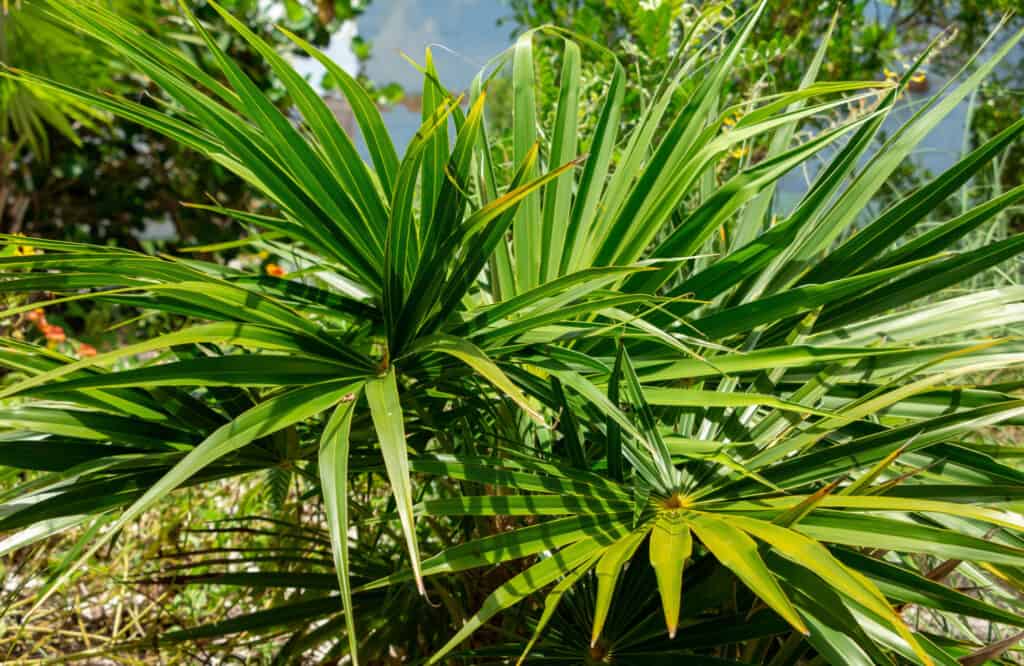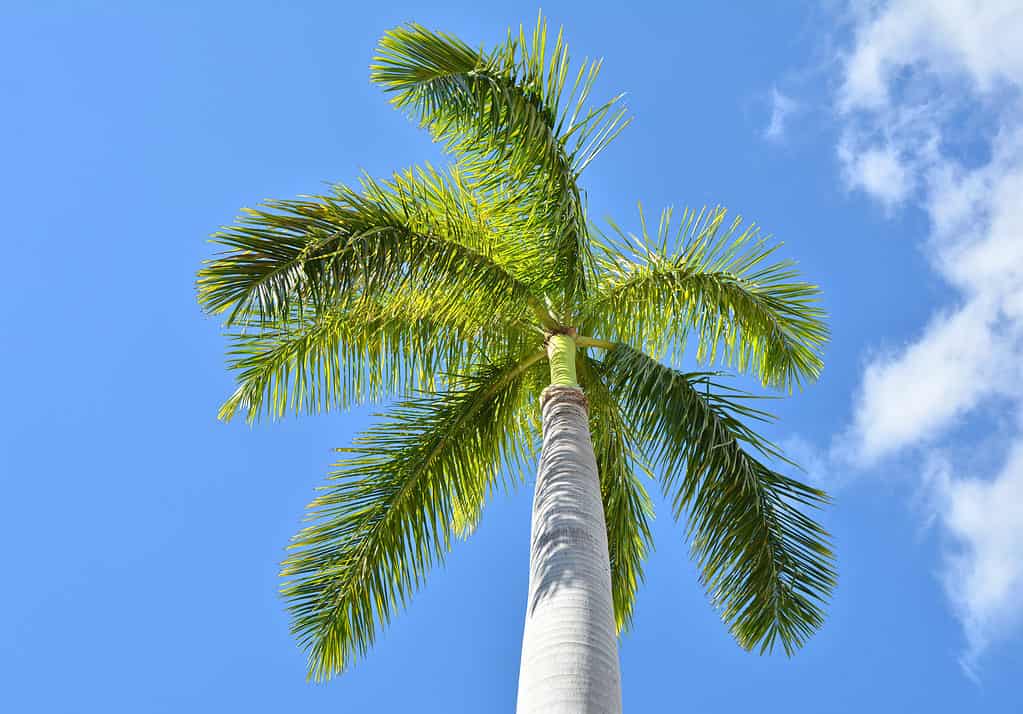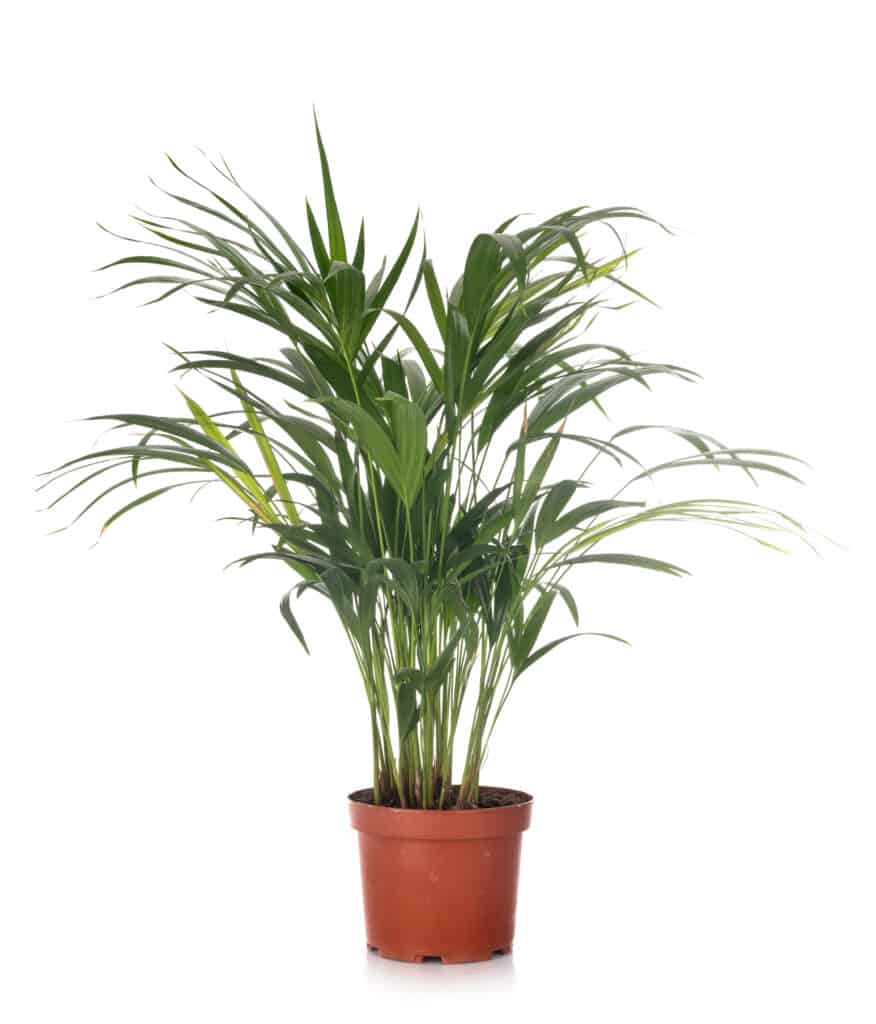Quick Answer:
- Discoloration is a sign that your palm’s overall health is compromised and could potentially die if not remedied.
- Overwatering, overfertilizing, improper temperatures, or too much sun exposure can result in palm trees turning brown.
Your tropical landscaping can receive a beautiful color boost from evergreen palms. They are also perfect as large indoor plants and can add a tropical vibe to any household. But what can you do to restore the rich, green color of your palm tree’s leaves when they become brown?
To start, take a closer look at the tree’s surroundings if you find that your outside palm tree’s leaves or fronds are starting to turn brown. How is the water supply for the tree? Is the sun hitting the tree a little too hard? When was the last time you checked the nutrient content of the soil? You can change these elements to support your tree’s health if you find that it is receiving too much or too little water, sunshine, or nutrients.
With those solutions in mind, what should be done about palm trees turning brown? It is perfectly fine to remove any brown, dead fronds from your palm tree. But unless they represent a risk to the region directly below, attempt to leave brown fronds that are just half brown or brown fronds with green stems on the tree. They will fall off naturally without any intervention.
Brown fronds are often a normal component of the growing phase of the palm tree. However, discolored fronds can also serve as a warning to you that your palm tree is not receiving enough nourishment to keep healthy.
In this article, we’ll go into more depth about what could be causing palm trees to turn brown, some other common problems that palm tree owners might face, and potential solutions for all of these potential problems.

Most palm species (pictured) suffer from browning or yellowing leaves at some point in their life cycle.
©Sunshower Shots/Shutterstock.com
Causes and Solutions for Palm Trees Turning Brown
When you notice your palm trees turning brown, you’ll want to figure out what’s happening not just for the tree’s aesthetic appeal but also for its health. After all, discoloration is a sign that your palm’s overall health is compromised and it could potentially die if not remedied. Brown fronds on palm plants are often caused by the following issues listed below, along with some solutions.
Overfertilizing
Even interior trees like the parlor palm or areca palm require fertilizer as part of their maintenance. However, if you’re not careful, there are several fertilizer blunders that might turn the leaves of your palm tree brown. For example, it’s possible that the drainage method you choose for your palm is insufficient. As a result, the fertilizer cannot leave the soil properly. The plant becomes overfed with fertilizer when more is added on top of it.
Maybe you didn’t realize you were using a slow-release fertilizer. You may have purchased the proper type of fertilizer, but you are unsure of how much or how frequently to apply it, so you give your palm tree a generous helping whenever it feels appropriate. This could be a problem. If you can see a discernible layer of fertilizer crust encircling the base of your plant, you’ve gone way overboard with your fertilizer. Your stately palm tree’s fronds will have gone brown, maybe even yellow.
You probably don’t realize how little fertilizer palm plants actually need. Fertilizing shouldn’t be done every month or even every few months. As an alternative, fertilize your palms one to three times each year. The first fertilizer application may be made in the spring as your palm starts to grow.

Indoor palms such as the parlor palm (pictured) require regular fertilizer just as much as outdoor palms do.
©iStock.com/Wheatfield
Overwatering
Indoor palms cannot tolerate either too little or too much water, and they will immediately display indications of either plant owner faux pas. When only an inch of the soil in your indoor palm is dry, you should water it. By inserting a clean finger into the pot of your palm and feeling for wet soil, you can determine the soil’s moisture content. Your palm won’t require water for a few days if the tip of your finger is still wet after you remove it. This is the easiest way to determine if your palm needs water.
It’s still not time to water the palm tree when you sense a little bit of dampness in the soil, but it will be shortly. Likewise, you’ve waited too long if the ground feels bone-dry. The oldest fronds of a palm tree will initially become brown when it is water-starved, but this discoloration can also affect the younger leaves. The growth of your palm may potentially slow down or cease altogether without proper watering. It’s also bad if the fronds turn yellow instead of brown, which will often happen from overwatering and underwatering alike. Recognizing the problem and reducing the amount of water you give your plant now might save it from dying later.
Palm trees are susceptible to root rot, much like any indoor plant species. The tree’s base will decay in addition to the roots beneath the soil. Your tree will eventually no longer be able to maintain itself structurally, which can be potentially dangerous if your palm is very tall and planted outside. Dead roots might cause it to die if it doesn’t collapse first. So, always check your soil regularly if you notice signs of overwatering or underwatering.
Improper Temperatures
Palm trees are typically associated with warm and humid locations like Florida or California in the United States as well as tropical islands of Hawaii and elsewhere outside of the States. The fact that palms only grow where it’s consistently warm is not a coincidence. They are unable to endure colder climates. Both indoor and outdoor palms cannot handle cold climates under any circumstances.
Depending on how frosty the conditions become, palm trees might suffer from three different forms of cold damage. A cold injury, which can happen when it’s 40 degrees F or even 45 degrees F outside, is the least serious. Despite being less severe, cold injuries can nonetheless result in frond mortality. The fronds of your palm tree will become brown before they perish.
Frost injuries, which are the second highest in severity, occur when temperatures dip into the low 30s. Your palm tree fronds will likely perish in higher numbers than they would from a cold injury. It might seem likely that the palm tree will live once the temperatures warm up, but even then, it will take up to a year for it to recover.
The most serious injuries are caused by hard freezes. These palm tree wounds develop from prolonged exposure to extremely low temperatures. New fronds will likely develop but then die off after older ones. The apical meristem of the palm, which is the area close to its fresh leaves, shoots, as well as its root tips, will likewise die. Given that the meristem cannot regenerate, this will likely result in the death of the tree.
Unfortunately, there is no solution to this problem. Everybody wants a palm tree, but some climates simply cannot accommodate them!
You shouldn’t have to worry about cold injuries that are more severe than those brought on by temperatures around 45 degrees F since your palm tree is an indoor plant. Keep your indoor space between 65 and 85 degrees F, and you should not notice any leaf browning on your palm tree.

Palm trees (pictured) need warm temperatures to thrive and most species are not cold hardy.
©Studio Barcelona/Shutterstock.com
Too Much Sun Exposure
Despite the fact that palm trees are always found in the warmest climates, this does not imply that they can tolerate prolonged sun exposure. It’s actually the complete opposite. The delicate fronds of your palm tree can quickly turn brown when exposed to intense sunlight. Reviewing how much light your indoor palm receives is an excellent idea if you discover that your fronds also feel sharp to the touch.
Bright indirect light is the ideal type of sun exposure for the majority of indoor palms. Keep in mind that your indoor palm doesn’t receive direct exposure to bright indirect light from a window. The sunlight will first hit a surface or pass through something before it reaches your plant. In other words, something must be blocking the passage from your palm to the sun. That may be a shade or possibly a curtain. Your palm can be covered by the leaves of a bigger indoor plant as well.
After positioning your indoor palm to get bright indirect light, make sure it absorbs that light for four to six hours each day. Due to shorter days and less frequent sun exposure throughout the winter, this can become more challenging. Feel free to use grow lights to make up for insufficient natural light; your palm will certainly thank you.
Common Palm Tree Issue: Molding
Outside of palm trees turning brown, palm trees can suffer from other problems. One common issue is mold. Although it doesn’t significantly injure the tree, the ashy gray or black mold that targets palm trees is ugly and not very aesthetically pleasing. The extra sugar byproducts in insect feces cause the mold to grow. Because of this, resolving pest problems is crucial to getting rid of this type of mold. Smaller palms can benefit from spraying while taller, more mature palms that are challenging to spray benefit more from systemic soil-based treatments.
Common Palm Tree Issue: Fungal Infections
Numerous fungal diseases that are prevalent in warm, humid climates can affect palm trees. Fungi can cause the trunk of the tree to decay, have unusual wilting, and generally have poor development. It is crucial to remove an infected tree as soon as possible to safeguard other trees since these illnesses can spread swiftly. To prevent the transmission of these illnesses, it is essential to sanitize pruning equipment between plants as well.
Common Palm Tree Issue: Pruning Incorrectly
Your palm tree’s health may be significantly impacted by improper trimming techniques. These trees store food and energy in their fronds, and it is crucial to leave the fronds on the tree until they are totally brown in order to prevent the tree from losing the stored food that they need to thrive. To prevent shock and deprivation, just 15% of the fronds of a palm tree should be pruned. Don’t overdo it, even if you don’t like the brown or yellow look of some of your plant’s fronds!
Palm trees turning brown is a common issue that can be easily remedied with a bit of attention and time. And growing palm trees is relatively easy and definitely worth it if you want to add a tropical element to your indoor space or landscaping project. By knowing the potential issues you might face in raising a palm tree, you can better defend against those issues in the future.
Bonus: Which Type of Palm is the Easiest Plant for Beginners?

Kentia palms are easy to care for and are pretty additions to any home.
©cynoclub/Shutterstock.com
If you are new to caring for plants and are looking for a low-maintenance beginner plant that offers a lot of bang for your buck – consider the Kentia palm! This slow-growing palm will tolerate anything – shade, cold, and even small spaces. Once it is established, it requires very little care and is considered to be one of the most low-maintenance and easy-to-grow tropical plants. Kentia palms require watering every 7 – 10 days – after allowing the water to dry out of the top two inches of soil. If you want to pamper your palm – mist it regularly or clean its leaves with a damp cloth to remove dust. It will reward you with lush, shiny foliage and pure, clean air to breathe for up to 50 years!
The photo featured at the top of this post is © iStock.com/Tamar Dundua
FAQs (Frequently Asked Questions)
Why do palm tree leaves turn brown?
Lack of proper watering and nutrients in the soil (such as nitrogen or magnesium) can cause leaf browning in palm trees.
Why do palm tree leaves turn yellow?
A lack of nutrients in the soil (such as manganese) and generally poor soil can cause yellow leaves in palm trees.
Should I cut off yellow or brown leaves on my palm tree?
Yellow leaves should be left alone, while brown leaves or fronds can be removed.
Thank you for reading! Have some feedback for us? Contact the AZ Animals editorial team.







